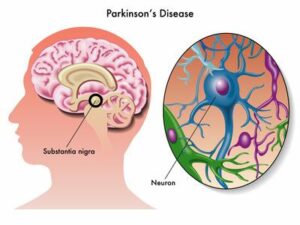Introduction
Parkinson’s disease is a neurodegenerative disorder that affects movement and coordination. It occurs when the brain’s dopamine-producing cells gradually degenerate, leading to a deficiency of dopamine—a neurotransmitter responsible for smooth and coordinated muscle movements. Parkinson’s disease is chronic and progressive, and while there is no cure, there are treatments available to manage symptoms and improve quality of life.

Symptoms
The symptoms of Parkinson’s disease can vary from person to person and may develop gradually. Common symptoms include:
Tremors: Involuntary shaking or tremors, typically starting in the hands, fingers, or limbs at rest.
Bradykinesia: Slowness of movement, making everyday tasks more challenging and causing stiffness and rigidity in the muscles.
Muscle stiffness: Stiffness and rigidity in the muscles, leading to reduced range of motion and difficulty with mobility.
Postural instability: Impaired balance and coordination, which can increase the risk of falls.
Changes in gait: A shuffling gait with shorter steps and reduced arm swinging.
Speech and swallowing difficulties: Soft, slurred speech and problems with swallowing.
Non-motor symptoms: These can include depression, anxiety, cognitive changes, sleep disturbances, and loss of smell.
Diagnosis
Diagnosing Parkinson’s disease involves a thorough evaluation by a healthcare professional.
The process may include:
Medical history and physical examination: A detailed discussion of symptoms, medical history, and a neurological examination to assess motor function.
Response to medication: If symptoms improve significantly with Parkinson’s medication, it can help confirm the diagnosis.
Imaging tests: Magnetic resonance imaging (MRI) or computed tomography (CT) scans may be performed to rule out other conditions that may cause similar symptoms.
DaTscan: A specialized imaging test that can help distinguish Parkinson’s disease from other movement disorders.
Treatment
While there is no cure for Parkinson’s disease, treatment aims to manage symptoms and improve quality of life.
Treatment options may include:
Medications
Dopamine replacement medications, such as levodopa, can help replenish dopamine levels in the brain and alleviate motor symptoms. Other medications may be prescribed to address specific symptoms, such as tremors or sleep disturbances.
Deep brain stimulation (DBS): This surgical procedure involves implanting electrodes into specific areas of the brain, which deliver electrical impulses to alleviate motor symptoms.
Physical therapy: Physical therapy can help improve muscle strength, flexibility, balance, and coordination, enabling better mobility and reducing the risk of falls.
Speech and swallowing therapy: Speech and swallowing exercises can help improve speech clarity and swallowing function.
Occupational therapy: Occupational therapy focuses on adapting daily activities and improving fine motor skills to enhance independence and quality of life.
Supportive care: In advanced stages of Parkinson’s disease, palliative care and supportive therapies may be provided to manage symptoms and improve comfort.
Life style Changes
In addition to medical interventions, certain lifestyle changes can help manage Parkinson’s disease:
Regular exercise: Engaging in regular physical activity, such as walking, cycling, or swimming, can help maintain muscle strength, flexibility, and overall well-being.
Balanced diet: Eating a nutritious, well-balanced diet rich in fruits, vegetables, whole grains, and lean proteins can support overall health.
Adequate rest and sleep: Prioritizing sufficient rest and practicing good sleep hygiene can help manage fatigue and improve overall well-being.
Social support: Maintaining social connections and participating in support groups or counseling can provide emotional support and a sense of community.







